Of all the natural forces that erode (wear away) the land, the sea is the most powerful. It carries sand particles that act like a grindstone on the shore. Waves are forced into cracks in the rocks. They widen the cracks, eventually breaking up the rock face. Huge cliffs are carved out of mountains; broad platforms are sliced back through rocks, and houses are left dangling over the edges of the land.
New land can also be created at the ocean's edge. Where headland cliffs are being eroded by waves, the boys between may fill with sand. On coasts where the sea is shallow, waves build beaches of shingle, sand, and mud. The first experiment demonstrates the destructive effect of the sea when it hits the shore. The second project shows how waves make ripples on sandy beaches.
YOU WILL NEED
- Making waves:
Sand, plastic bucket, water tank, water, pitcher.
- How ripples are formed in sand:
Heavy filled round can, round dishwashing bowl, pitcher, water, fine, clean sand, spoon.
ATTACKING THE SHORE
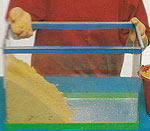 STEP 1
STEP 1
Mix a little water with the sand in a bucket, until it is very wet and sticks firmly together. Then pack the sand into a wedge shape at one end of the tank.
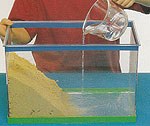 STEP 2
STEP 2
Carefully pour water into the empty end of the tank, so as not to disturb the sand too much. Fill the tank until the water level comes about two-thirds of the way up the sloping sand.
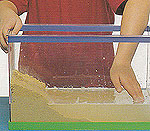 STEP 3
STEP 3
Make gentle waves in the water on the opposite side of the sand. Notice how the waves gradually wear away the slopping sand. This is what happens on a seashore.
HOW RIPPLES ARE FORMED IN SAND
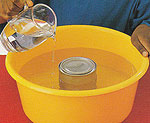 STEP 1
STEP 1
Place a heavy can in the centre of the dishwashing bowl, then fill the bowl with water to at least half way. The water should not cover more than two-thirds of the can.
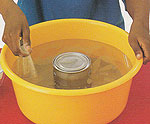 STEP 2
STEP 2
Sprinkle a little sand into the bowl to create a thin layer about 1/4 in deep. Spread the sand until it is even, then let it settle into a flat layer at the bottom of the bowl.
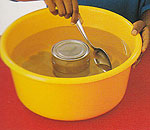 STEP 3
STEP 3
Stir the water gently with the spoon. Drag the spoon in a circle around can tin. As the water begins to swirl, stir faster with the spoon, but keep the movement smooth.
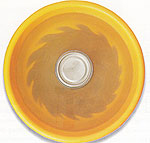 STEP 4
STEP 4
As you stir faster, lift the spoon out and let the water swirl around by itself. The sand will start to develop ripples. As you stir faster, the ripples become more defined.
Back to School Projects Main








